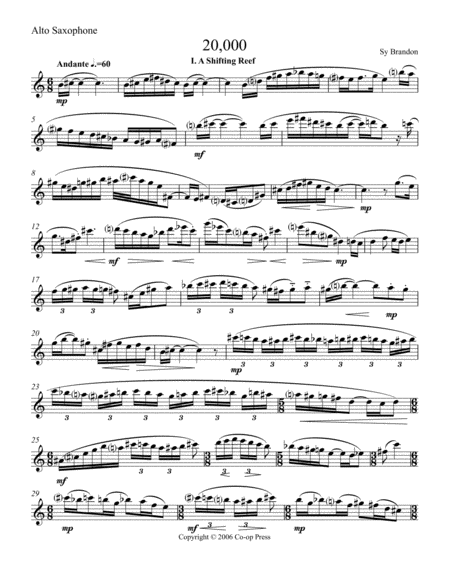Alto Saxophone Solo - Level 5 - Digital Download SKU: A0.755094 Composed by Sy Brandon. 20th Century,Concert,Contemporary. Individual part. 10 pages. Sy Brandon #3381815. Published by Sy Brandon (A0.755094). Based on Jules Verne’s 20,000 Leagues Under the Sea I. A Shifting Reef – This movement depicts the Nautilus as an unknown phenomenon that is a threat to navigation. Some mariners thought it was a sea monster and others thought it was a shifting reef. No one could conceive that it was a boat capable of traveling under water. The music is ever changing throughout this movement. It constantly shifts tonality, melodic ideas, and rhythmic placement of motives. Although some ideas repeat, they are transformed by combining them in different patterns with other previously stated ideas. II. A Walk at the Bottom of the Sea Through a Submarine Forest – Circular breathing is used at the beginning and the end of this movement to represent an undersea walk. The musical material appears in reverse at the end representing a return to the Nautilus. The lighter middle section represents walking over a more rocky terrain. The multiphonics symbolize the wonders of the submarine forest. III. The Giant Squids – The giant squids have surrounded the Nautilus and have caused the propeller to jam. In order to free themselves, Captain Nemo, his crew, Professor Aronnax, Conseil, and Ned Land do battle with the squids. This energetic scherzo reflects on the dangers of the battle. Several screams are heard as the squids entangle Ned Land and other crewmembers. The short multiphonics and syncopations represent the men chopping away and the arms of the squid. At the end, the Nautilus finally frees itself after the loss of one life. IV. Trapped Near the South Pole – After discovering the South Pole, the Nautilus is returning to open waters when it is caught between the polar icecap and iceberg that flips over. The tremolos reflect the doom of the Nautilus as only two days of air supply remain. The only means of escape is to chop through the ice below the Nautilus. The staccato notes represent the crew members hacking away at the ice. When that fails, Captain Nemo tries to melt the ice by expelling hot water from the Nautilus. This is represented by the saxophonist blowing air through the saxophone and wiggling the keys. A sense of doom returns that is followed by a final attempt of the Nautilus to crash through the remaining ice. A triumphant ending reflects the success of this attempt. V. The Maelstrom – As Professor Aronnax, Conseil, and Ned Land attempt their escape from the Nautilus, the ship enters the feared maelstrom, a vortex off the coast of Norway where no ship has escaped. The swirling waters are represented by the triplet passages and the escape by the duplet passages. An epilogue using the doom music of the previous movement suggests the end of the Nautilus but a brief return to a slower version of the Shifting Reef motive perhaps suggests otherwise
